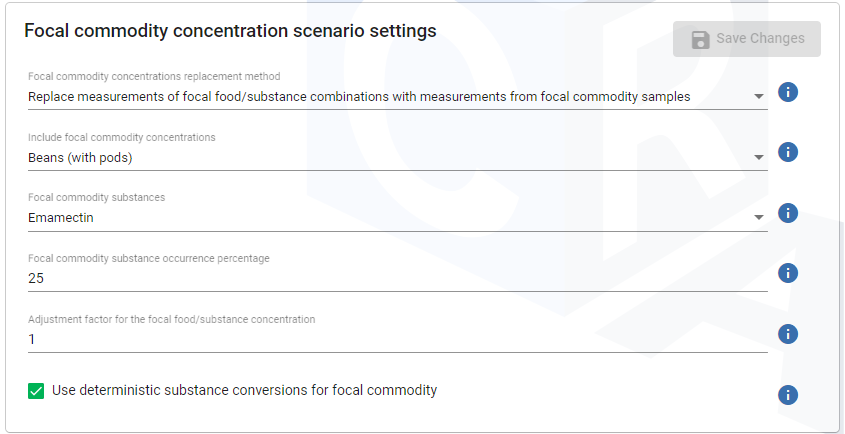Focal commodity scenario analysis¶
There are different methods for modifying the (background) concentration data for specific (prospective) focal commodity scenario analyses. In the front end, these focal commodity scenario analysis method are accessible through the option include focal commodity concentrations. Checking this option will open the focal commodity scenario analysis form (see Figure 22) where the method and the focal commodity food/substance can be selected, and accompanying other settings can be configured.

Figure 22 Focal commodity scenario analysis form of the front end. This form is a sub-form of the concentrations module panel.¶
Replace samples with focal commodity samples¶
This method will replace all samples for the selected focal commodity food by samples from the focal commodity concentration data. It works substance independent, and will therefore replace all substance concentrations of the focal commodity food in the background concentration data.
Append focal commodity samples¶
This method adds the focal commodity samples of the selected focal commodity food to the background concentration data. This method is also substance-independent and may be a useful approach when the substances measured in the field trial do not overlap with the substances of the (background) concentration data. In this case, the focal commodity substance concentrations will be missing for the background concentration data and (also the other way around) the substance concentrations of all other substances will be considered missing for the focal commodity samples. These missing values may be imputed at a later stage following the “normal procedures”.
Replace measurements of focal food/substance combinations¶
This method replaces, for the selected (focal) combination of food and substance, all substance concentrations with focal concentrations. This method knows two variants:
Replace by focal commodity samples: The focal food/substance measurements are obtained from focal commodity samples. Here, substance measurements of the focal commodity food in the background concentration data set are replaced by randomly assigned substance measurements of the focal commodity samples.
Replace by concentration limits: The focal food/substance measurements are obtained from focal commodity samples. Here, substance measurements of the focal commodity food in the background concentration data set are replaced by the concentration limit value (e.g., an MRL) obtained from the provided concentration limits data.
Using the focal commodity substance occurrence percentage, it is possible to specify an occurrence percentage for the combination of focal food and substance. When this percentage is less than 100%, this will partly (i.e., for the selected percentage) replace the concentrations of the focal commodity food and substance with the focal concentrations, and for the other part replace the concentrations with zero concentrations. E.g., when aiming to replace background concentrations of the substance fluopyram on potatoes with an MRL value, then specifying a focal commodity substance occurrence percentage of 40% will replace 40% of the measurements with the MRL, and 60% of the measurements with zero concentrations. Note that, because the allocation is random (i.e., each substance measurement has a probability of being assigned a focal concentration or a zero defined by the percentage), the realized replacement percentage may differ from the specified percentage. This option can, for example, be used to simulate a percentage of agricultural use.
Using the adjustment factor for the focal food/substance concentration, it is possible to adjust the (positive) concentrations of the focal food and substance measurements. This factor can be used when the focal commodity concentrations (e.g., from field trials) are assumed to be higher than what may be reasonably expected in practice. In this case, this factor could be set for instance, to the expected ratio of mean monitoring concentration and mean field trial concentration. Note that for replacement by focal commodity measurements, this factor will only adjust the positive concentrations and not the LORs.
By default, the focal commodity substance measurements are replaced before the optional step of converting the concentrations from measured to active substance concentrations. This also means that for these replaced measurements, the same rules apply, and the measurements may be converted to active substance measurements after replacement. Alternatively, it is possible to replace substance measurements after having done the allocation, and to use deterministic substance conversions factors for the focal commodity food and substance to convert these measurements to the level of active substances.
Note that when also using using substance authorisations, the focal food and substance combination will be treated as authorised, even if there is no authorisation supplied for the combination. The approved authorisation status is considered to be part of this scenario analysis.
Remove measurements of focal food/substance combinations¶
This method will simply remove all background concentrations for the selected focal commodity food and substance combination, and will not replace them with other values. This method may be useful when a separate analysis is desired for the background and foreground concentrations.